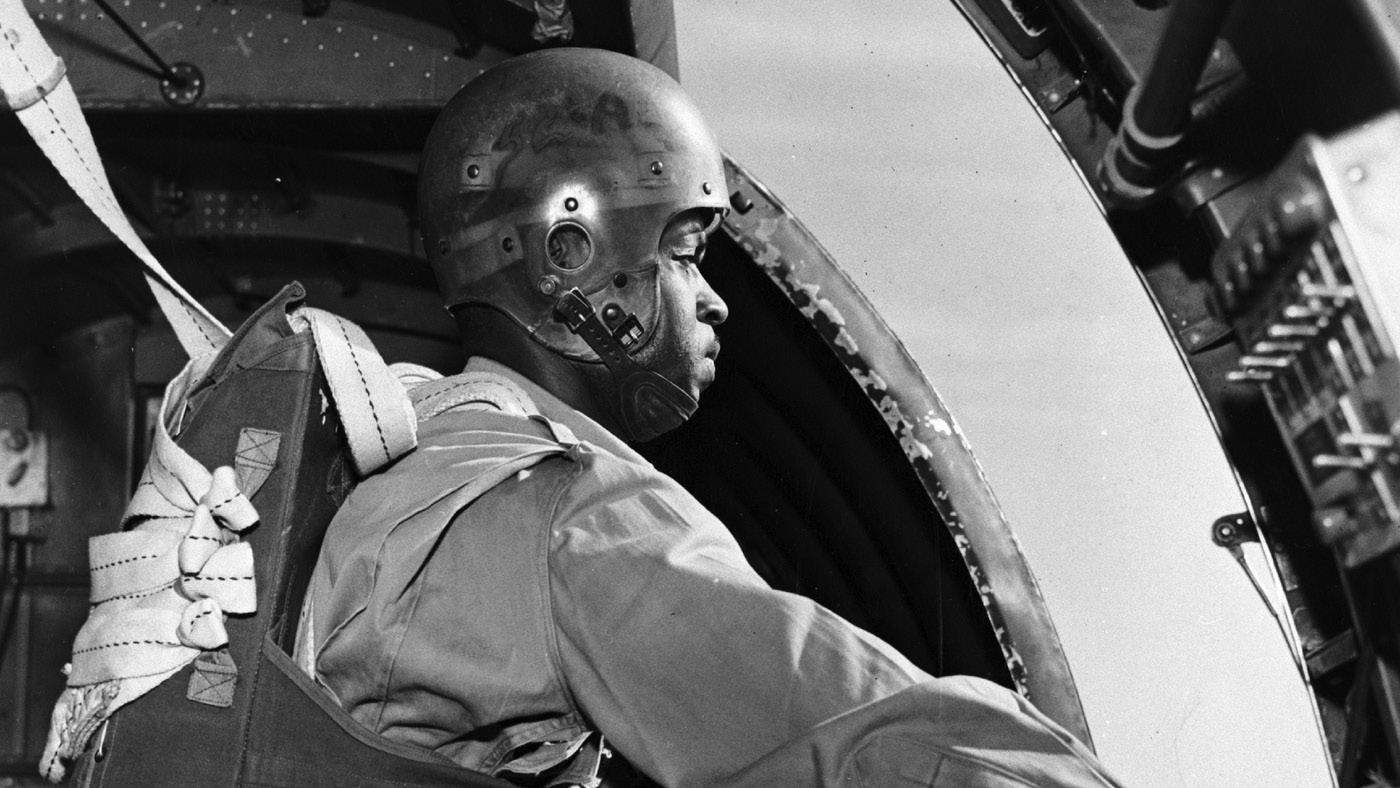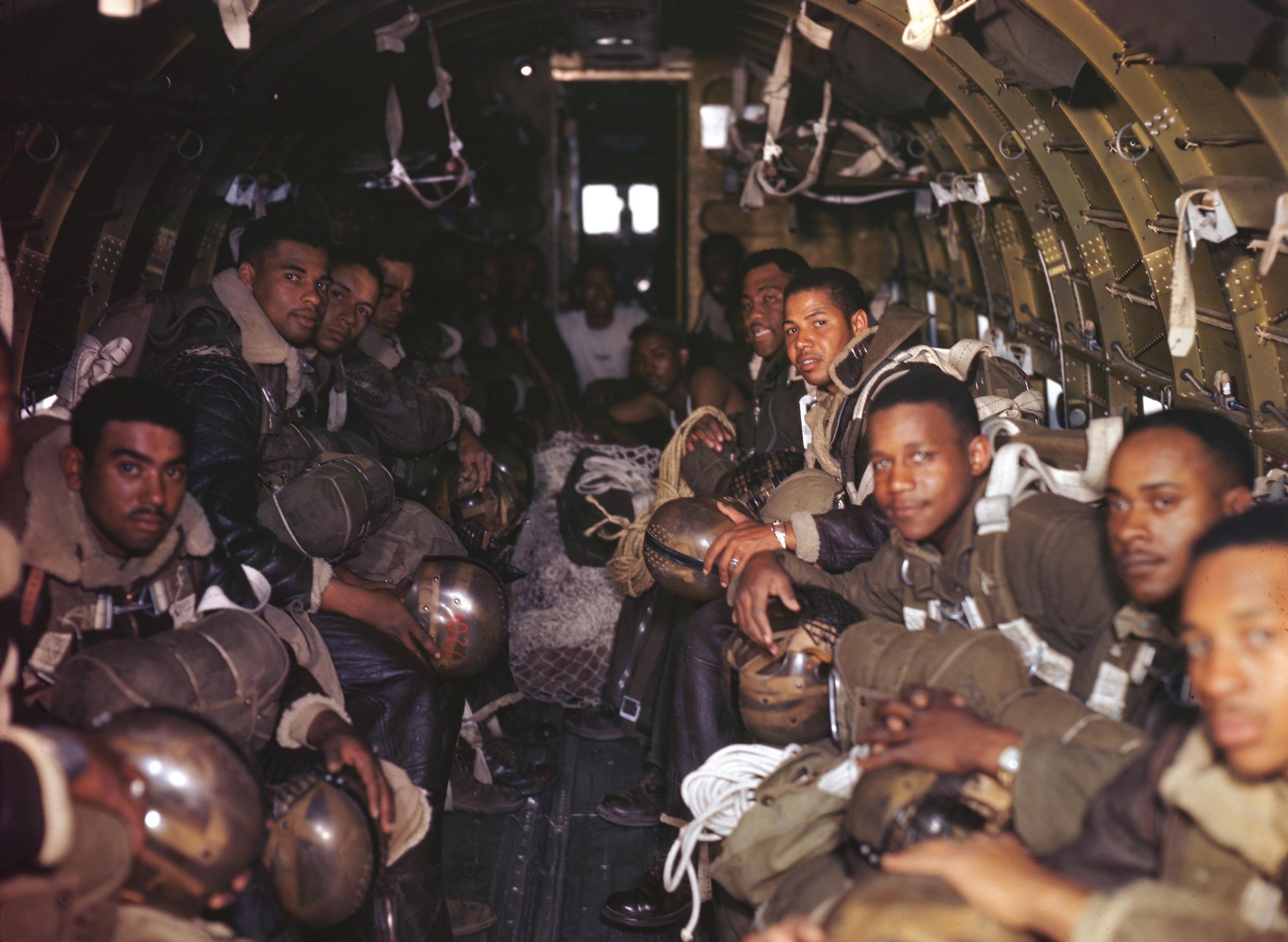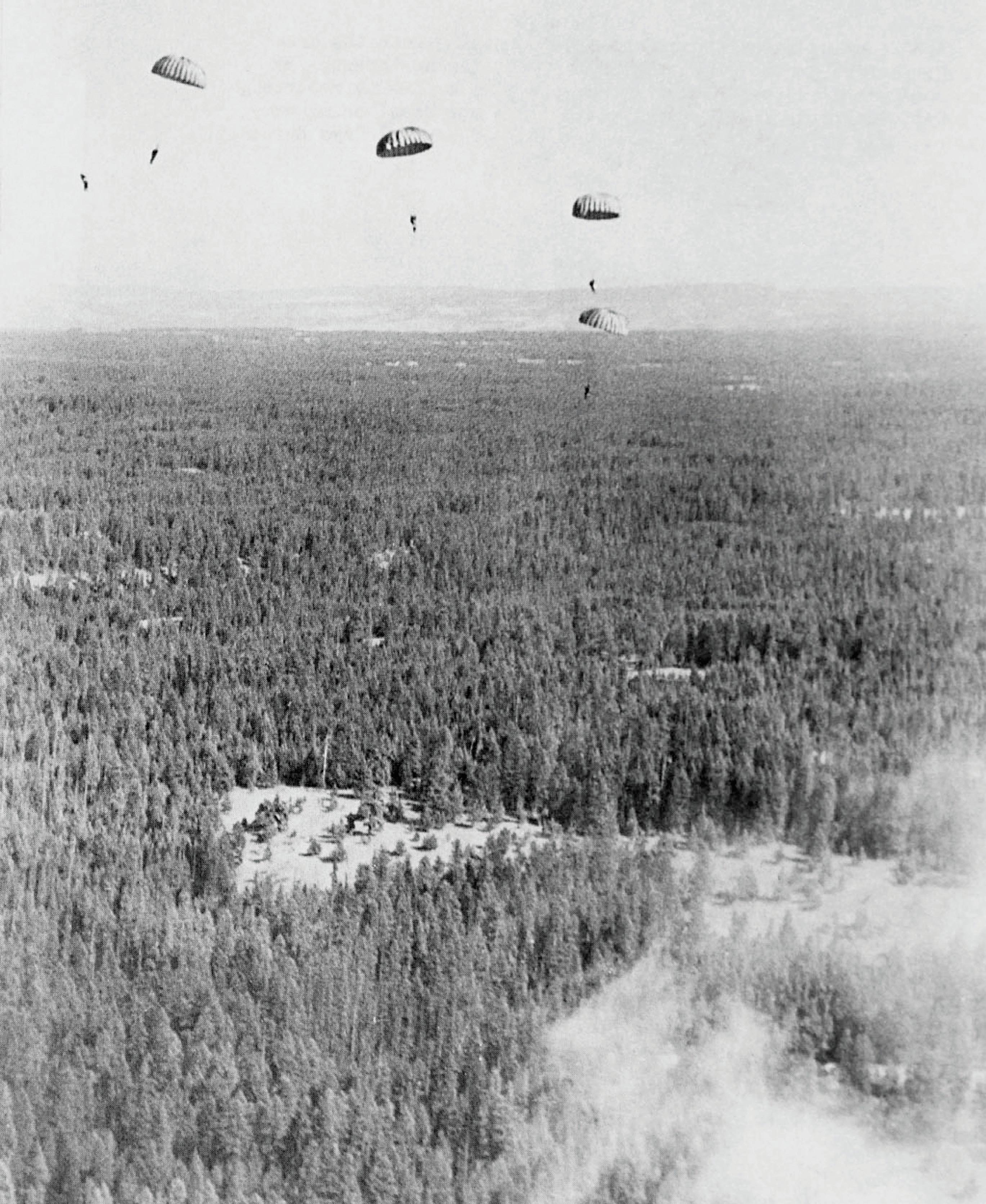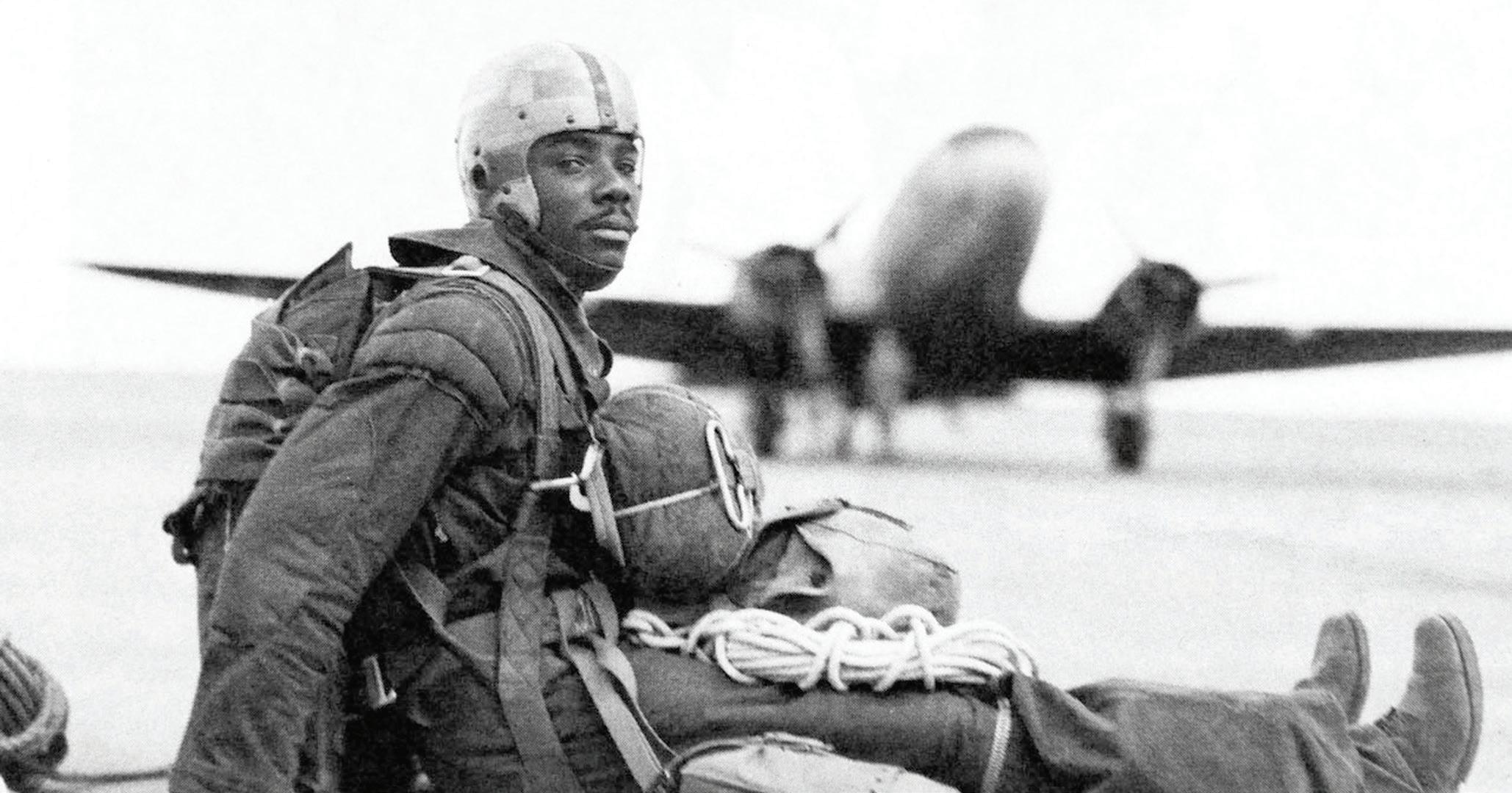
7 minute read
The Secret WWII Mission of Oregon's Triple Nickles
The Secret World War II Mission of Oregon's Triple Nickles
Seventy-five years later, the Triple Nickles leave a lasting legacy in Pendleton
written by Matt Wastradowski
ON MAY 5, 1945, the all-black 555th Parachute Infantry Battalion—more commonly known as the Triple Nickles—boarded a train for Pendleton Field in rural Oregon. The soldiers, comprising the nation’s first all-black parachute infantry and the first military smokejumpers in U.S. history, had trained for months at Camp Mackall in North Carolina when they received a classified mission that spring.
“The men were anxious—really, really anxious—and were thrilled to have a part [in World War II],” said Dr. Bob Bartlett, a public sociologist at Eastern Washington University who has studied the history of the 555th Parachute Infantry Battalion.
But the soldiers remained unclear on their mission, known only as Operation Firefly, as they made the cross-country trip. “Even at that point, they thought, ‘Maybe we’re going to Japan, because at least we’re going West,’” Bartlett said.
The soldiers never went to Japan. Nor did they fight in Europe.
Instead, the Triple Nickles—yes, that spelling is by design—spent their summer in Pendleton, fighting a secret war far from public view and even farther from the front lines. This war would be fought not with guns or bombs, but with parachutes and fire hoses. And, as the battalion boarded that train in North Carolina seventy-five years ago this spring, that secret war was claiming its first lives some 2,800 miles away in Southern Oregon

Smokejumper Jesse Mayes prepares to jump.
National Archives and Records Administration/courtesy of Oregon Travel Information Council
“Balloon Bombs” Strike the U.S.
When the Triple Nickles boarded that train, Japanese forces had been creating elaborate “balloon bombs” designed to start fires and cause mass panic throughout the United States.
The balloons, each about 33 feet in diameter, were filled with hydrogen gas, tethered to a basket (similar to a hot air balloon), and armed with conventional bombs and incendiary bombs. In all, the Japanese military sent roughly 9,000 balloon bombs into the jet stream during World War II, hoping that each would sail across the Pacific Ocean before making landfall in the United States and exploding on impact. “Their goal was to burn the whole West Coast, thus causing panic and diverting attention away from the war,” Bartlett said.

A Japanese balloon bomb during World War II.
National Museum of the U.S. Air Force
And to an extent, the plan worked: Balloons landed as far north as Alaska, as far south as Mexico, and as far east as Iowa. But only one bomb claimed the lives of U.S. citizens—and that balloon was discovered on May 5, 1945, just outside the town of Bly, roughly an hour east of Klamath Falls in Southern Oregon.
That day, minister Archie Mitchell—along with his pregnant wife, Elsie, and five children from their Sunday school class—went for a picnic near Bly. Mitchell parked the car while Elsie and the children went ahead. They told Mitchell they’d found a balloon—but it exploded before he could warn them against touching it. The explosion killed Elsie and the children.
World War II Takes a Toll
The tragedy marked the only time Americans were killed by enemy fire in the continental United States during World War II—but it was far from Oregon’s only brush with war. A Japanese submarine shelled the U.S. base at Fort Stevens in June 1942, near the mouth of the Columbia River, and a seaplane dropped a bomb in a forest near Brookings later that summer, causing minor damage. (The latter was the first aerial bombing on the U.S. mainland by a foreign enemy.)
By 1945, when the balloon bomb exploded near Bly, Oregonians were understandably on edge. “During World War II, most people in coastal communities had bags by the door, ready to go, with food and family pictures—kind of like you would in tornado country,” said Doug Kenck-Crispin, resident historian for the Kick Ass Oregon History podcast. “And it was because of a Japanese invasion, that’s what they feared.”
The U.S. Army, worrying that news of the deaths would incite further panic, worked to keep the balloons out of the headlines.
“They did not want the American people to know they were being bombed by this secret weapon, and they did not want the Japanese to know they were successful,” Bartlett said.
But the Triple Nickles, traveling west, had no way of knowing any of that.
The Triple Nickles Arrive in Pendleton
World War II had been raging for years by the time the Triple Nickles came to Pendleton, and black service members stationed in the United States had lobbied President Franklin D. Roosevelt and First Lady Eleanor Roosevelt to allow them to serve in combat units. The Army was heavily segregated at the time, and it wasn’t until December 1943 that the 555th Parachute Infantry Battalion was officially activated.
The Triple Nickles arrived in Oregon in May 1945 and reported to the mostly deserted Pendleton Field just outside town. There, they were briefed on Operation Firefly: The battalion would train with the U.S. Forest Service to become the military’s first smokejumpers, deactivate balloon bombs, and put out wildfires—whether caused by bombs, lightning strikes or careless campers. “Most of them were like, ‘What are you talking about?’” Bartlett said of the soldier’s reactions. “They were told Pendleton was their new home, and that they were not going to join the war overseas. They were trained to put these fires out, get hauled out, and not talk about it.”

The Triple Nickles prepare for a jump.
National Archives and Records Administration/courtesy the Oregon Travel Information Council
All summer long, the battalion did just that, deactivating bombs and fighting wildfires all over the Pacific Northwest and in southern Canada. Of the 300 members, 200 remained in Pendleton; the others were sent to Chico, California.
One smokejumper died that summer—Private First Class Malvin L. Brown died in August 1945, when he fell from a tree while fighting a fire on Lemon Butte near Cave Junction. Brown is the first smokejumper to die on a fire jump.

The Triple Nickles embark on one of thirty-six fire missions undertaken in the summer of 1945.
National Archives and Records Administration/courtesy of Oregon Travel Information Council
Black Paratroopers Face Discrimination
When not fighting fires, the 555th faced racism and discrimination in Pendleton.
In a sense, it wasn’t all that surprising. The Provisional Government of Oregon had voted to exclude all black settlers from the state just 101 years earlier—and when Oregon became a state in 1859, it was the only free state admitted to the Union that prevented African Americans from establishing residence. In fact, the last of the state’s anti-exclusion laws weren’t repealed until the mid-1920s—just two decades before the Triple Nickles arrived in Pendleton.
Around town, the men couldn’t eat in most restaurants, their visiting families couldn’t rent hotel rooms, and locals didn’t make them feel welcome. Officer Bradley Biggs wrote a book about the 555th—The Triple Nickles: America’s First All-Black Paratroop Unit—and in it, he described only being able to drink at two bars around town. “There were just places they couldn’t go, that they knew were off limits to them,” Bartlett said.
Bartlett said the men, nonetheless, found ways to make the most of the time in town. They hunted, fished, attended the Pendleton Round-Up that September, and even put together a softball team—and competed against friendly locals. A few members even took flying lessons while stationed at the airfield. But by and large, they kept clear of downtown. “To the majority of the folks in Pendleton, they were like ghosts,” Bartlett said. “These guys were invisible.”

A member of the Triple Nickles at the military air base in Pendleton.
National Archives and Records Administration/courtesy of Oregon Travel Information Council
The Triple Nickles' Legacy
When wildfire season ended that fall, the 555th had participated in thirty-six fire missions with more than 1,200 individual jumps, according to the Oregon Encyclopedia. The battalion was then assigned to Fort Bragg, North Carolina, that October, where it became a key part of the previously all-white 82nd Airborne Division.
Some seventy-five years later, the legacy of the Triple Nickles continues to be felt—and honored— in Pendleton.
In the summer of 2018, a plaque was installed in downtown Pendleton, touting the group’s bravery, dedication and sacrifice for serving its country. It was the second such recognition of the Triple Nickles’ time in Pendleton—the nearby Pendleton Air Museum hosts a small display with information on the group and Operation Firefly. Another marker pays tribute to Malvin Brown and the Triple Nickles at the Siskiyou Smokejumper Museum in Cave Junction.
As Bartlett sees it, the recognition is better late than never. Even if they only spent a few months around Pendleton in the waning days of World War II, the Triple Nickles played a key role in protecting the region, preventing mass panic, and paving the way for future smokejumpers—regardless of race. That, he said, warrants recognition. “This is where it all started,” Bartlett said. “If anywhere there should be a marker or museum, it needs to be in Pendleton.”



